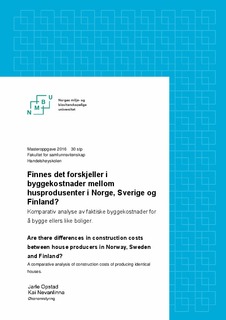| dc.contributor.advisor | Bengtsson, Jens | |
| dc.contributor.author | Nevanlinna, Kai | |
| dc.contributor.author | Opstad, Jarle | |
| dc.date.accessioned | 2016-08-31T12:48:42Z | |
| dc.date.available | 2016-08-31T12:48:42Z | |
| dc.date.issued | 2016-08-31 | |
| dc.identifier.uri | http://hdl.handle.net/11250/2403168 | |
| dc.description.abstract | Det går en debatt i Norge om at det er dyrt å bygge nytt. Det finnes lite konkret data om dette, men derimot mange meninger om hva de dyre byggekostnadene skyldes. Blant annet strenge byggtekniske krav, lav produktivitet, høye lønninger og et særnorsk kostnadsnivå blir nevnt i denne debatten. Samtidig finnes det statistikk som viser store kostnadsforskjeller mellom Norge, Sverige og Finland, og derfor skal oppgaven ta for seg kostnadsnivået i byggebransjen i disse nordiske landene.
Formålet med oppgaven er å belyse forskjeller mellom landene og mellom konkurrentene i samme land, for bygge ellers like boliger. Ved å samle inn kvantitative data fra store husprodusenter i alle disse landene, har vi konkrete tall på eventuelle forskjeller. Dataene blir fordelt i material- arbeids- og underentreprenørkostnader, og i tillegg blir byggemetode (precut eller storelement) analysert som en mulig årsak til forskjeller.
Våre funn viser at Norge er dyrest, Sverige litt billigere (ca. 10 %) fulgt av Finland som er klart billigst av alle (ca. 35 % billigere enn Norge). Vi fant også stor variasjon innad i Norge og Sverige. Ved å fordele totalkostnaden på ulike kostnadselementer kunne vi se at det var stor variasjon i forskjellene mellom disse kostnadselementene. For eksempel kostnaden for ytter- og innervegger (største enkelte kostnadselement) er ca. 20 % lavere i Sverige enn i Norge, mens for yttertak er det omtrent motsatt forskjell. Et interessant funn er også at timekostnaden for en byggarbeider er 14 % høyere i Sverige enn i Norge. Antall timer er allikevel lavere, så den totale arbeidskostnaden er lavere i Sverige. Det er også store forskjeller i typiske underentreprenørkostnader. For eksempel er kostnaden for flisarbeidet i Finland hele 75 % lavere enn i Norge. Sverige er billigere enn Finland på VVS, men når det gjelder grunn og fundament er de dyrest av alle. Produsentene som kjøper inn materialer selv, istedenfor å kjøpe dem via underentreprenørene, har en lavere totalkostnad på disse postene.
Siden vi kun har data for tradisjonelle eneboliger på ca. 140 m2, kan vi ikke uten videre generalisere resultatene til å gjelde for byggekostnader generelt. Likevel tror vi dataene gir et godt bilde av kostnadsforskjeller i markedet for eneboliger og småhus. | nb_NO |
| dc.description.abstract | There is a discussion in Norway that it is expensive to build new houses. While there is little
specific data about this, there are rather many opinions on the reasons for high construction costs.
Strict technical requirements by government, low productivity, high wages and a locally high cost
level in Norway is mentioned in the discussion. In addition, there are statistics showing large cost
differences between Norway, Sweden and Finland, and therefore we will in this thesis analyze
the cost level in the construction industry in these Nordic countries.
The purpose of the thesis is to highlight cost differences between countries and between
competitors in the same country, for construction of identical houses. By collecting quantitative
data from large house constructors in all these countries, we have specific figures on differences.
The data is distributed into material, labor and subcontractor costs, and in addition, it is analyzed
if the construction method (precut or large wooden elements) has a cost impact.
Our findings show that Norway is the most expensive, Sweden slightly cheaper (approximately
10 %), followed by Finland, which has the lowest costs (about 35 % lower than Norway). We
also found large variation between constructors within Norway and Sweden. By distributing the
total cost into various cost elements, we could see that there was considerable variation in the
differences between these cost elements. For example, the cost of the outer and inner walls
(single largest cost element) is approximately 20 % lower in Sweden than in Norway, while we
can see roughly opposite difference for roofs. An interesting finding is that the hourly cost of a
construction worker is 14 % higher in Sweden than in Norway. The number of hours is still
lower, so the total labor cost is lower in Sweden. There are also large differences in typical
subcontractor costs. For example, the cost of tile work in Finland is 75 % lower than in Norway.
Sweden is cheaper than Finland on sanitary, heating and ventilation, but is the most expensive of
all with regard to foundation work. Producers who purchase materials themselves, rather than
purchasing through subcontractors, have a lower total cost of these cost elements.
As we only have data for traditional detached houses of about 140 m2, we can not simply apply
the results to construction costs in general. However, we believe the data gives a good impression
of cost differences in the market of single family houses. | nb_NO |
| dc.language.iso | nob | nb_NO |
| dc.publisher | Norwegian University of Life Sciences, Ås | |
| dc.rights | Navngivelse-Ikkekommersiell-IngenBearbeidelse 3.0 Norge | * |
| dc.rights.uri | http://creativecommons.org/licenses/by-nc-nd/3.0/no/ | * |
| dc.subject | Byggekostnader | nb_NO |
| dc.title | Finnes det forskjeller i byggekostnader mellom husprodusenter i Norge, Sverige og Finland? Komparativ analyse av faktiske byggekostnader for å bygge ellers like boliger | nb_NO |
| dc.title.alternative | Are there differences in construction costs between house producers in Norway, Sweden and Finland? A comparative analysis of construction costs of producing identical houses | nb_NO |
| dc.type | Master thesis | nb_NO |
| dc.subject.nsi | VDP::Mathematics and natural science: 400::Mathematics: 410::Analysis: 411 | nb_NO |
| dc.source.pagenumber | 66 | nb_NO |
| dc.description.localcode | M-ØA | nb_NO |

